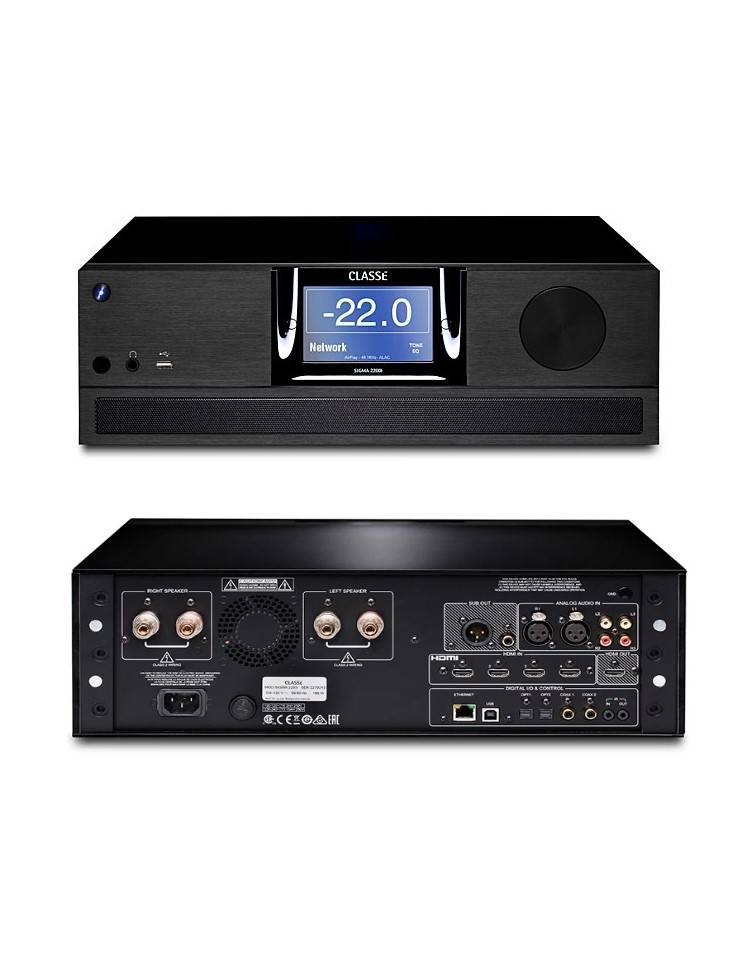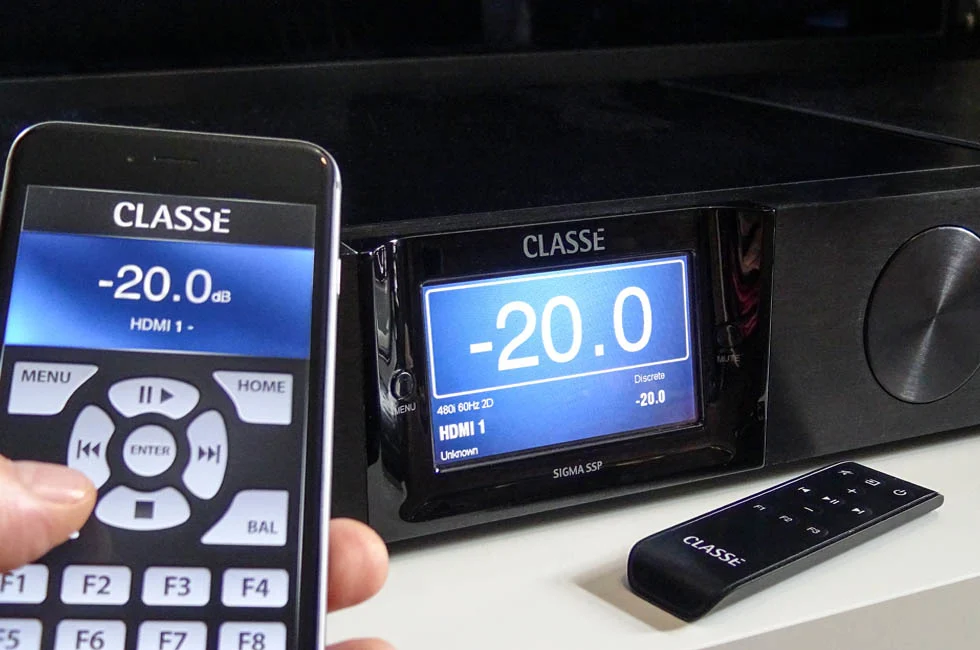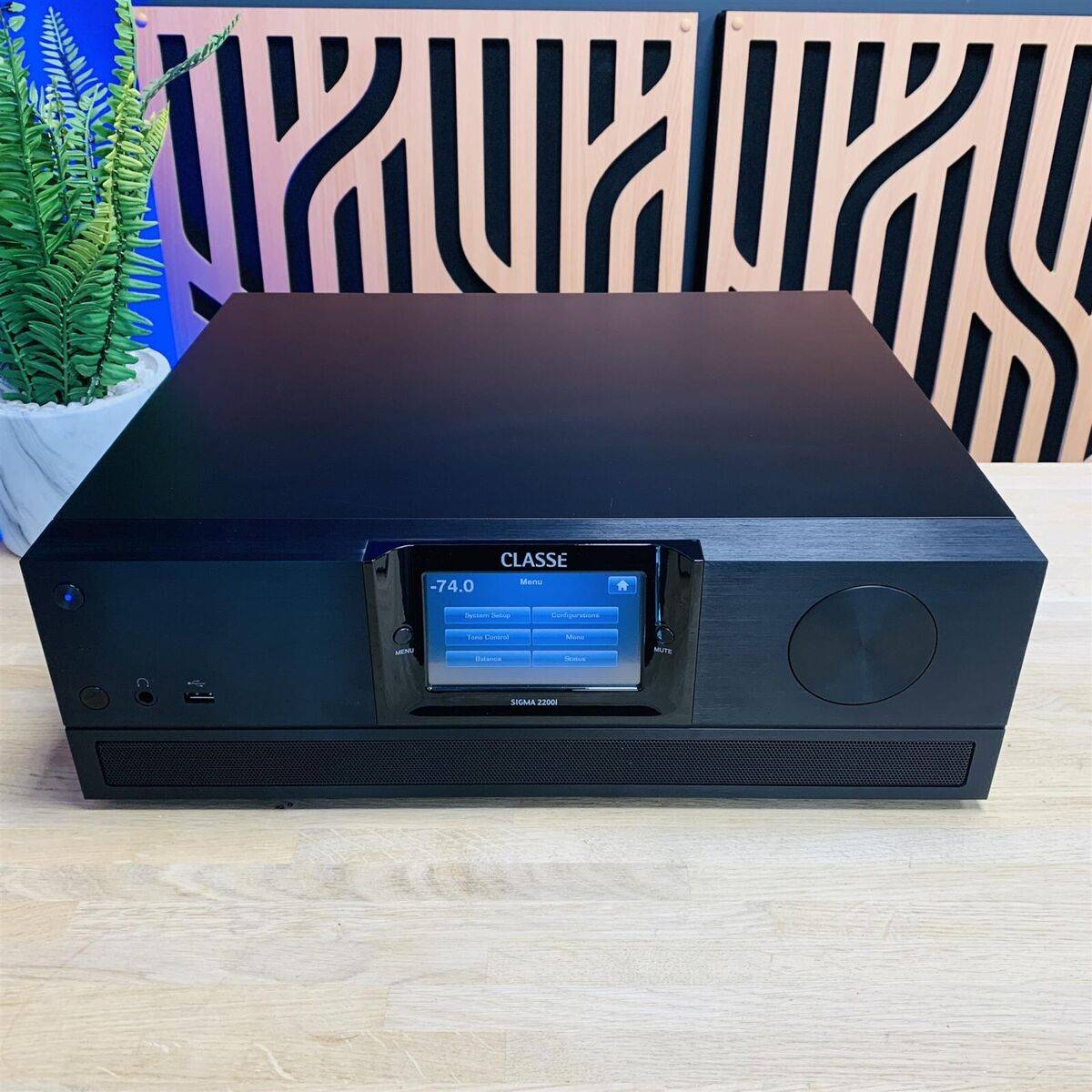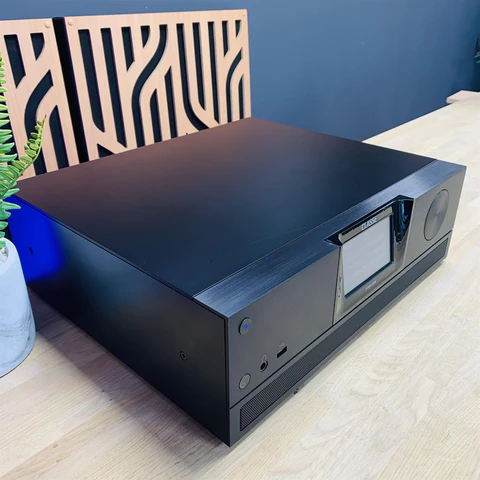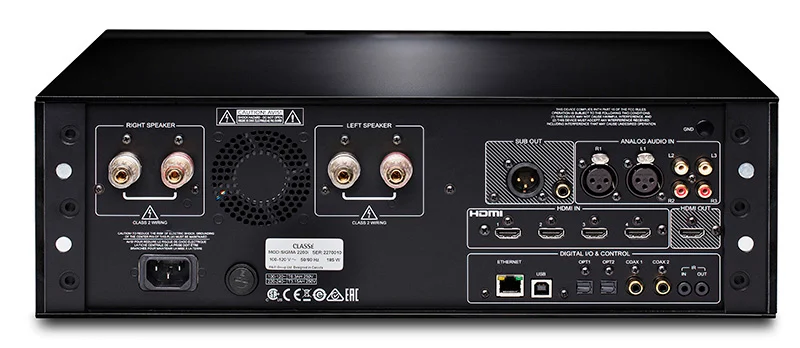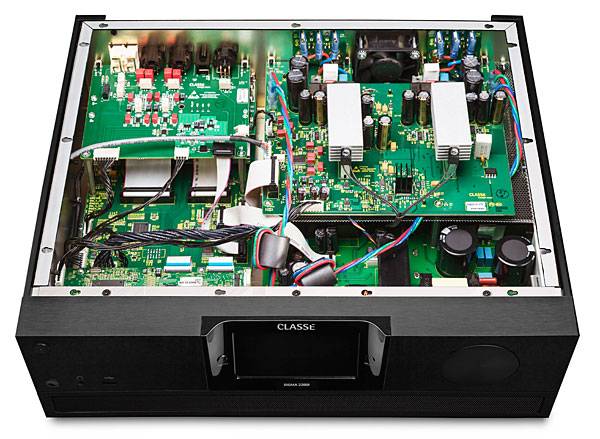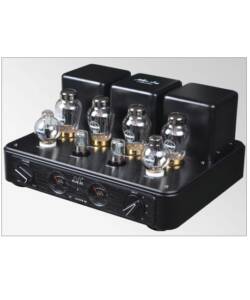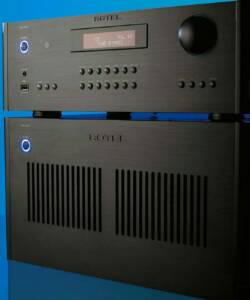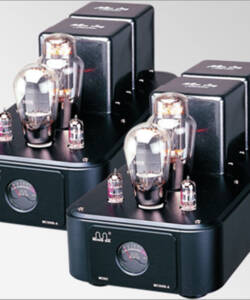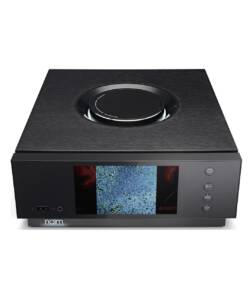Classe Sigma 2200i Integrated Amplifier with DAC
Original price was: R142,000.00.R38,000.00Current price is: R38,000.00.
Introduction
The Sigma 2200i is a powerful stereo integrated amplifier with features like USB and Network streaming, HDMI 2.0 switching and bass management to accommodate the evolving needs of a modern hi-fi system. It leverages the technical and performance advantages of our Sigma series separates to punch seriously above its weight class. As an integrated amplifier, the 2200i combines preamp and power amp functions in a single chassis. What’s special is its direct digital connection between the preamp section and the amplifier, which eliminates losses by removing digital-to-analog and analog-to-digital conversions from the signal path.
The preamp section of the 2200i features connectivity and circuit blocks found in the Delta series CP-800 and Sigma SSP. Inputs include fully balanced (XLR) and single-ended (RCA) analog with optional MM/MC phono, digital coax, optical, USB host and device, Ethernet for streaming and IP control and HDMI switching. Techniques like asynchronous synchronization and master clock mode allow us to manage the digital clocks for low jitter and high signal integrity. Analog sources are converted at 24/96 to preserve their original bandwidth and dynamic range.
Specifications
Description
Classé Sigma 2200i integrated amplifier

The last few years have seen a flood of new integrated amplifiers in an audiophile market traditionally wedded to separate preamps and power amps. That might reflect the fact that integrated amps make a lot of sense, and not only because they usually cost less than equivalent separates. The latter gained a foothold in audio’s Paleolithic era, when tubes were the only game in town. Tubes generate lots of heat—an enemy of electronics—and separating the preamp stages from the output devices kept this under control. Yes, there were integrated amplifiers back then, but they were generally of very low power—25Wpc was once considered monumental.But when cooler-running solid-state components became practical, they followed the same path, probably more because of tradition than necessity. Audiophiles expected separates, and considered integrated amps to be, at best, mid-fi receivers with delusions of grandeur.
The result is that today’s market is awash with discrete electronic boxes of every variety: DACs, phono preamps, line-level preamps, power amps, headphone amps, even room equalizers. Some of these devices themselves comprise separate enclosures for their housekeeping circuitry and power supplies.
So while not everyone agrees that incorporating all of a system’s electronics into a single case is a good idea, it’s hard to deny its practicality. There are, of course, different levels of consolidation. Some integrated amps include just a line-level preamp and stereo power amp; others do virtually everything. While adding more functions of course adds to the cost, a single box can still be more economical than separates because it eliminates several (perhaps pricey) cables and duplicate, expensive cases. A single box also tidies up the system, dramatically increasing its acceptability to the home’s resident interior decorator.
There are disadvantages to the one-box approach: If one part of a system of separates fails, you don’t have to bring the whole system to the repair shop; updates to separates are easier to make, though likely more expensive; and separate pre- and power amps offer flexibility in placement.
Some will argue that keeping the digital and analog circuits well apart offers audible benefits. I don’t generally agree, particularly with well-designed products—and Classé’s Sigma 2200i ($5500) is well designed and more: Inside its solid, spare, classic black case is every component and feature listed above.
Design
At a specified 200Wpc into 8 ohms (400Wpc into 4 ohms) and a net weight of 26.7 lbs, and with a lack of visible heatsinks, the Classé 2200i wouldn’t be expected to include a conventional class-AB or class-A power amplifier, with the heavy transformers and thick, overbuilt chassis those technologies require. And it doesn’t. The Sigma 2200i’s amplifier is class-D, employing a switch-mode power supply and pulse-width modulation (PWM).
Nor is there an analog bypass: Incoming analog sources are immediately converted to a 24-bit/96kHz datastream. After passing through the digital preamp and signal-processing stages, the signal is converted to PWM at a high sampling rate of 384kHz, then fed in that form to the class-D amp. Finally, it’s passed through a low-pass filter to eliminate the PWM signal’s high-frequency carrier, and returned to an analog output to drive the speakers.

Regarding a class-D amp as “digital” is controversial, as many argue that PWM is not digital in the usual sense. PWM doesn’t employ traditional D/A and A/D conversions. It does produce pulses at a high sampling rate, but these pulses represent the signal by varying in width. A traditional digital datastream comprises a string of identically sized bits grouped as “words.” Each word is composed of ones and zeros and characterized by how many of each are included and how they’re distributed.
While a short description of the 2200i won’t distinguish it from most of the digital amplifiers now on the market, Classé maintains that they use proprietary digital technology that offers superior performance. The 2200i doesn’t use the OEM class-D modules, typically from ICE or Hypex, on which most of today’s digital amps are based. Instead, Classé uses a clean-sheet design that eliminates, they claim, the perceived sonic limitations of other class-D designs.
A more detailed discussion of PWM and of the Sigma 2200i’s class-D operation would fill the rest of this review; those who want to dig deeper should check out Classé’s white paper on the design of its CA-D200 power amplifier. Though not an integrated, the CA-D200 is the 2200i’s technological father.
Do-All Classé
All of the Sigma 2200i’s features can be controlled via its touchscreen and the Menu button to the left of the screen. (These are not directly duplicated on the remote, which offers limited setup control; see below.) To the right of the screen is a large, flush-mounted volume-control knob, which can also be used to adjust the balance, parametric EQ, tone controls, input offset, etc. The volume can be changed in increments of 0.5dB through the heart of the adjustment range—I’ve seen other products, not all of them budget-priced, that offer steps of only 1dB, which in my opinion is too coarse. The volume setting is displayed on the screen when no other adjustments are being made, with numbers large enough to be easily read from across the room. The screen can be set to three levels of brightness, or to go dark after an adjustable timeout period.
To the left of the touchscreen are the Power/Standby button, headphone jack, and a USB host connector, for portable media devices and firmware updates, that supports inputs up to 24/192.
Around back are: high-quality, insulated, left and right speaker terminals; one balanced and two unbalanced analog inputs (one of the latter can be fitted with an optional phono stage for moving-magnet and moving-coil cartridges, not included in our review sample); four digital inputs (two TosLink optical for PCM up to 24/96, two coaxial for PCM up to 24/192); and two subwoofer outputs (one balanced, one unbalanced). An asynchronous USB port supports digital sources up to 24/192 and can mate with a USB host such as a PC or Mac computer. Also on the rear panel is a small, low-speed cooling fan. I never heard it operating.

Because of the pure-digital signal path from input to output—to just before the 2200i’s final filter, which converts the PWM signal to analog—preamp out and power-amp in connections are not provided. And while, as noted above, the 2200i’s digital inputs can accept source signals of up to 24/192 (it can’t accept native DSD), these signals are immediately converted to 24/96, as all of the 2200i’s digital processing is performed at that resolution.
Apart from its IR remote control, the 2200i offers no wireless connectivity. The rear panel’s Ethernet connector can be used for Apple’s AirPlay or DLNA, and can also support IP control of the 2200i via Classé’s iOS or Android app (and/or home automation control) via a home network. There’s also an IR input, for use with a repeater when the Classé is out of range of its IR wireless remote control, and an IR output to pass commands along to another Classé component.
Because the 2200i is a dedicated two-channel device, and not multichannel in any respect, its most unusual feature is the inclusion of four HDMI (v.2.0) inputs and one HDMI output, supporting up to 2160p (4K) video at up to 60Hz, plus audio (including Audio Return Channel, or ARC). HDCP 2.2 is included on HDMI input 4. The 2200i performs no video processing or scaling, and the audio carried by the HDMI cable must be two-channel PCM. The Classé will not decode bitstream Dolby Digital or DTS, so you must set your disc player to convert these formats to PCM. All Blu-ray and universal disc players I know of can do this.
If the above video technobabble makes little sense to you, all you really need to know is that the Classé will accept stereo audio or audio/video PCM sources via HDMI, process this stereo information as it does for other digital inputs, and, if needed, pass any compatible video along to a display from its HDMI output. Bottom line for those who may be interested in these HDMI capabilities: The Classé can serve as the heart of both a two-channel audio system and a 2.0-channel video setup.
The 2200i can also serve for 2.1-channel—that is, left and right speakers plus a mono-only subwoofer(s). It can be set up in one of three configurations: full-range main speakers with no sub; full-range mains plus sub with selectable low-pass filter frequencies and slopes of 6, 12, or 24dB/octave; and low-pass on the sub and high-pass on the mains with the same filter options. However, you must select the same rolloff rate and frequency for both the high- and low-pass filters: You can’t mix and match. For example, you can’t select 40Hz at 24dB/octave low-pass for the sub and 12dB/octave at 80Hz high-pass for the mains. (While such a split setup sounds odd, in some cases it can help to achieve a smoother response at the mains-to-subwoofer transition.) You can also leave the Classé’s filters out entirely and rely on the sub’s own filter(s) to keep it from singing along with the main channels. The 2200i offers no gain or phase controls for the subwoofer, so be sure that your sub does (most do).
The Classé offers some of the most extensive selections of tone-control and equalization options on the two-channel market. The tone controls can be used as either conventional bass and treble controls, or as a tilt control. While the defaults for the latter are 200 and 2000Hz (the ±3dB points), you can change these if desired. In tilt mode, the frequency balance is affected like a seesaw: the top end rises and the bottom end falls, or vice versa, as you tweak the control. In either case, the control limits are ±6dB.
There’s more. Each channel of the 2200i offers six parametric-equalization (PEQ) filters with manually selectable center frequency, gain, and Q. (The Q is the width of the frequency band affected by the filter: the higher the number, the narrower the band.) Similar controls are offered for a connected subwoofer.
But while the tone and tilt features can be accessed and used intuitively by anyone, the PEQ filters should ideally be adjusted only with the help of in-room measurement equipment and the ability to use it—and for most buyers, this will mean an experienced acoustical technician. The Classé’s PEQs offer no automated setup, such as that provided by Anthem Room Correction (ARC) or Audyssey. At the September 2016 CEDIA Expo, Anthem introduced an ARC-equipped, two-channel integrated amp that could be a competitor for the Sigma 2200i—while ARC offers the benefit of automation, Classé provides more flexible and personalized adjustments.
Many audiophiles blanch at the thought of using tone controls and/or EQ. With the Classé, you don’t have to enable either, but they’re provided for those who want them. All of the classic preamps referred to earlier offered tone controls. They weren’t intended for room correction (in the Audio Paleolithic, no one thought about that), but rather as help for less-than-ideal recordings.
The 2200i’s remote control is small enough to sneak behind the seat cushions if you’re not watching carefully. It has buttons for power, input, mute, and navigation, plus three function buttons that can be programmed to access various features. I set up F1 to access the configuration menu (for choosing subwoofer on or off), and F2 to access the PEQ menu (to turn it on or off rapidly to quickly sample its effect). Once in the selected menu, you can use the navigation controls to move around within that menu or return to the home menu, though from the listening seat it’s not easy to see, on the 2200i’s front-panel display, which of these options you’ve selected. The Classé’s Android and iOS apps presumably offer more flexible control that’s also legible close up, but connecting the 2200i to my home network via a wired Ethernet link to use the apps wasn’t practical, as the Classé has no WiFi capability.
Listening
I did all of my listening via a digital link from my Marantz UD7007 universal BD player, plugged into one of the Classé 2200i’s coaxial digital inputs. Since the 2200i immediately converts all analog inputs to digital, it made little sense to use the player’s analog outputs and thus add unnecessary D/A and A/D conversions in player and amp.
La Folia, by Gregorio Paniagua and Atrium Musicae de Madrid (CD, Harmonia Mundi Musique d’Abord 1951050), is a fascinating recording that makes use of conventional instruments (flute, harpsichord, etc.) plus a slew of the unexpected—kazoo, car engines, Jaw’s harp, duck call, chirping birds, church bells, and myriad other sounds I couldn’t readily identify. Many selections begin as conventional chamber music, but after a few minutes a wild, dynamic effect barges in to completely change the mood. A prime example of this is track 8, in which a flawless, four-minute flute solo is suddenly followed by a startling crash that segues into “Turkey in the Straw” punctuated by the sound of an antique car horn. But it all works. The Classé didn’t miss any of it, including the recording’s exceptionally clean and defined top end, startling dynamics, solid soundstage, good depth, the venue’s spacious acoustic, and every other plop, crash, burble, and squeak.

The 2200i’s presentation of Leo Kottke’s acoustic guitar and voice in his My Father’s Face (CD, Private Music 2050-2-P) was crisp but not exaggerated. The sound of most tracks, particularly those without vocals, was a bit too warm, but more often than not I found this more inviting than off-putting. Nevertheless, the Classé slighted no details, including guitar riffs that ranged from Kottke’s delicate fingering in slower numbers to his slightly growly voice in more upbeat, complex songs, including “Why Can’t You Fix My Car”—the only song I’ve ever heard that pleads for competence in an auto mechanic.
Nils Lofgren’s Acoustic Live (CD, Vision Music VMCD1005) is a very different recording of guitar and voice. It’s exceptionally dynamic, which is likely why one track, “Keith Don’t Go,” is a staple at audio shows. For a live recording, it’s remarkable—if it sounds bad, you can be sure it’s the system’s fault. It sure didn’t sound bad here. From the opening riff, the Classé 2200i passed along all of the recording’s excitement, from Lofgren’s up-front instrument to his voice. If the result was, like the Kottke, a little warm, that was clearly at least partially an issue of the speakers and my room.
My listening continued, and varied widely: choral recordings, male and female vocals, hard percussion, small groups, and full orchestral works, including film scores on CD. I was never disappointed by what I heard from the Classé Sigma 2200i. It handled everything effortlessly.
Comparisons
There’s no question in my mind that the Classé Sigma 2200i was a superb amplifier, but describing the sound of one amplifier without comparing it directly to the sound of another can leave the reader rudderless. Since I don’t have a wide selection of high-end two-channel gear lying around, I put the Sigma 2200i up against my resident surround-sound setup with only its front-left and -right channels in operation. This signal chain comprised a new Marantz AV8802a preamplifier-processor and a Proceed Amp 5, a five-channel power amplifier rated at 125Wpc into 8 ohms—significantly less power than the Sigma offers. The class-AB Proceed was discontinued shortly after 2000, but it’s a superb product that was made by the same company that still designs and builds Mark Levinson amps.
The prices of these two amplification chains are roughly comparable. The Marantz pre-pro sells today for $4000. The Amp 5 was marketed at $5000 in 1997, which would likely translate to about $8000 today. While that $13,000 combination buys you five channels, if it were two channels of the same quality it would likely still be priced competitively with the 2200i ($5500). (The cost curve as the number of channels change is nowhere near linear.) And I risk kicking a hornet’s nest by suggesting that there have been no dramatic developments in class-AB amplifier design in a very long time. Refinements, yes; revolutions, no.
I used the identical system for both amplifiers, the only difference being the 2m-long Cardas Hexlink Fives—interconnects that predate even the Proceed—between the pre-pro and the Amp 5. The latter interconnects, of course, were not needed for the self-contained Sigma.
I matched the levels as closely as possible. My preference with the Marantz pre-pro has always been to engage in only modest use of its tone controls: +1dB on the treble, but using neither its bass control nor its Audyssey room EQ. Measurements suggested that the frequency response was more evenly matched with the Marantz’s treble set to +1 and the Sigma flat, but since the difference at up to 10kHz was less than 0.4dB, I went with a +1dB treble-control setting on both, to be consistent. At these settings the Marantz was +0.4dB over the Sigma at 4kHz, they were matched at 8kHz, and the Sigma was louder than the Marantz by +0.4dB at 10kHz and by +1dB at 12kHz. You’d expect that this gave the Sigma an audible advantage in top-end detail and air, but the result was just the opposite.
Together, the Marantz AV8802a and Proceed Amp 5 comprise my current amplification, so I’m accustomed to their sound. While that might lead me to prefer them, I’m always open to improvements. Nevertheless, the Marantz-Proceed combo outmatched the Classé in one respect—it was more transparent in my system in the upper midrange and treble, an area vital to me. I went back and forth between the two setups dozens of times with a wide range of recordings, and in the end the Marantz-Proceed marginally edged out the Classé, with a more transparent quality and a subjectively faster but not overdone impact on transients. The 2200i did have the warmer, more organic sound—a quality that many audiophiles prefer. But the Marantz-Proceed hardly sounded clinical. It also seemed to produce a bit more depth, though that can be explained by its subjective, if not measurable, balance.
But the Classé offers capabilities that the Marantz does not, in particular its flexible parametric equalization. The warmth I noted above was also present in the Marantz-Proceed, although the latter’s other qualities rendered it less obvious. So some of the warmth was clearly a speaker/room issue. While many will find this appealing—and with most recordings it was far less obvious than indicated by my in-room speaker-response measurements—I set about minimizing it (see Sidebar, “Equalization Setup.”)
So began my adventure with the 2200i’s parametric equalization. But it wasn’t my first such adventure with Classé. Four years ago, in a different room, I made similar adjustments to their SSP-800 surround-sound processor, with positive effects on a surround array of www.soundandvision.com/content/bampw-802-diamond-speaker-system”>Bowers & Wilkins 802 Diamond speakers I was reviewing for Home Theater magazine. The result was outstanding, and one of the reasons I was anxious to review the Sigma 2200i.
The change in sound from adding PEQ to the system in my present room was relatively subtle with most recordings. It didn’t enhance the Classé’s top-end airiness enough to match that of the Marantz-Proceed (the EQ I added was all at or below 400Hz, the region where room problems are most prevalent), but the increased clarity through the bass and lower midrange that resulted from the reduction of excess warmth did open up the Classé’s sound to bring it closer to that of my reference gear. It also made me wish that the Marantz offered such a useful feature—or at least the option of limiting its Audyssey room compensation (which, again, I didn’t use) to a user-specified top frequency—perhaps the same 400Hz.
Near the end of the listening period I also tried connecting a Revel B15 subwoofer (discontinued) to the Classé, using the latter’s high- and low-pass filters, and the separate PEQ filter that can be used on the amp’s subwoofer channel. The result was a remarkable extension at the bottom end, with two shortcomings, neither the Classé’s fault: Flattening of the response made the midbass too lean. Pounding Kodo drums, for example, lacked realistic weight and body. This was the exact opposite of the common audiophile complaint about subwoofers producing a boomy, bloated bottom end. There was none of that here. In addition, even though the 2200i wisely limits the available boost in all bands to +3dB, the bottom-end EQ to flatten the sub’s output made my subwoofer’s 15″ drive-unit produce rude, unmusical noises that demanded that I reduce its level. The floor space dedicated to my setup is midsize, but connects to an open area that challenges any attempt to flatten out the response of even a large subwoofer.
In the right room, however, this capability might make the difference between okay and awesome sound. I might have had better luck in my room with two more bands of PEQ—one to raise the midbass slightly, the other to rapidly roll off the deepest bass—but I’d already used up all the subwoofer control available from the 2200i’s PEQ.
Sidelights I currently lack what some might consider state-of-the-art headphones, but I do have a pair of very good ones: PSB’s M4U 2 over-ear, noise-canceling model. They performed well with the Classé Sigma 2200i, which mutes the speakers when the headphone jack is in use. But the optimization of any given set of headphones with a specific headphone amplifier is a subject well beyond the scope of this review, or my experience.
I also tried the Sigma’s HDMI pass-through capability. It worked fine with 4K output (upconverted from native 2K) from an Oppo BDP-105D universal BD player, with one problem: There was a minor but annoying mismatch of audio/video lip sync—and the Classé provides no way to delay the audio to correct for this.
Conclusions
Despite my minor reservations about some aspects of the Sigma 2200i’s sound in comparison to an amplification system I’m intimately familiar with, the Classé is an excellent amplifier that will give pricier separates and other integrateds a run for their considerable money. In addition, it offers features that can address speakers-in-room problems in a way that most audiophile components do not. For that alone, it deserves a close look and a serious audition.
 I have to admit, I didn’t know much about Classé prior to being sent the 2200i for review.
I have to admit, I didn’t know much about Classé prior to being sent the 2200i for review.
I did know they were a Canadian company and had heard that they had been part of the Bowers and Wilkins Group for quite a few years now (since 2001 for those keeping tabs) and that the new 800 series speakers were developed with an intention to be paired with Classé amplification.
Of course amplification that is intended to be paired with very expensive speakers tends to be fairly highly priced itself, all this I knew.
What I did not know was that Classé had developed a more affordable series of components, the Sigma range, and that the power amplifiers were based on a class D design.
Background
With the 2200i arrival imminent, I did a little background research. I found that while this Integrated model of the Sigma range was indeed a merging of the power and preamp components within the line, it was also completely different at the same time.
The front-end consists of the stereo portion of the Sigma SSP, including inputs for USB types A and B, Ethernet for streaming AirPlay and DLNA, coax, optical, analogue inputs for XLR and RCA and an optional phono (as in the CP-800 and Sigma SSP). There’s also 4 HDMI inputs for users with AV sources.
Any analogue inputs connected to the Sigma are converted to digital at 24bit/96kHz resolution in order to be fed directly to the power amp section.
Many of the physical components may well be the same but the design philosophy is not, for you see the 2200i does not include a DAC chip. This is actually an area that I have some experience with, albeit mostly at a lower price point. I have heard several “Direct Digital Amps” as they have come to be called, and found them to be one of the more interesting developments in audio over the last few years.
A DDA, for those unfamiliar with the term, is an amplifier that takes a digital signal, throws it through a quick conversion (from PCM to PWM*) and then uses it to drive a switching amp directly. In this way the conventional DAC which is present in most designs is omitted, and the pre and post DAC filters are omitted as well. In theory this should lead to a musical signal that is closer to that on the digital storage media than one which has travelled through a DAC chip and analogue post-DAC board. The reality is a little more complicated than that of course but that is the main gist of the theory.
* Pulse Code Modulation and Pulse Width Modulation respectively, for those curious about what these codes actually mean, remember, both Google and Wikipedia are your friends.
I have been fortunate enough to have heard several DDAs over the past 5 years. Four were at much lower price points, all at or below the $1K mark. While they sounded rather good considering their price point, the Wadia 151 being the stand out performer of those, none of them really set my world on fire. NAD’s 390DD was quite a memorable amp and I know of several owners who thought it was truly something special but the Classé sits at a price point well above the 390DD, more aligned with the now discontinued M2.
For those of us who love to fiddle, this new offering from Classé provides touch screen access to several features. Source names are customisable; each input can be assigned a volume increase or decrease in order to avoid large changes in volume level when switching between sources. EQ, tone and balance controls are all included, treble and bass cut offs (and subwoofer crossovers) are adjustable as well as a tilt function. Maximum, minimum and start up volumes are all adjustable.
The EQ possibilities seem rather interesting and I was tempted to play with them, but in the end I left the Sigma in full range mode for my listening. Since I don’t use a subwoofer, full range is the only range I am interested in.
The Sigma boasts 200wpc into 8 Ohms and 400wpc into 4 Ohms and generates very little heat in the process thanks to those extremely efficient class D modules.
For the gear enthusiasts amongst us the Classé Sigma 2200i was tested using a YBA Heritage cd100 as a transport with digital signals sent from transport to amp across an Aurealis coax cable. Speaker cables were of generic nature, which proved a better match than others I tested. The Classé Sigma 2200i would be powering Lenehan Audio S2R stand mount speakers.
Listening Impressions
The top end is beautifully rendered with excellent resolution, the highs have a very natural feel to them and they are very easy on the ear, no traces of hardness, harshness or glare.
Trumpets are a touch soft and yet still maintain their full brassy stature. Triangle is a delight, it sounds very much like the instrument that little silver bells want to be when they grow up. Softly played piano is even more pleasing than usual. The top end is very, very nice and yet, even having said that, it doesn’t feel particularly extended. It sounds extremely good but it doesn’t seem to be trying to stretch its performance, almost as if Classé are playing it safe and sticking with the range they know the Sigma can do properly.
It isn’t really necessary as the upper treble is, as I said, very, very nice but I can’t help but feel that it could be just that bit better with just a little more effort. I really hope Classé push the envelope in this area when it comes time for a revised model to arrive.
The Midrange is where the magic starts to happen in earnest. The lead instrument mids are some of the best I have heard. The Sigma just brings out the most in every instrument in every tune I could throw at it. Electric guitars seem just slightly more electric, acoustic guitars hold on to that note decay for an extra few tenths of a second, while violins come across with more flair and piano down here is even better than it is in the top end. Truly excellent. Even music that I know has been seriously compressed comes across better in the mids than I was expecting.
